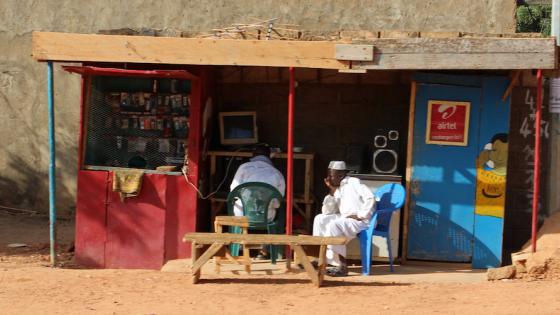In 2019 the world crossed a milestone point: half of the global population are now connected to the internet (Figure 1). However, digital transformation is not spread evenly. In richer developed nations almost 90% of people are online, but this number is less than 20% in the least-developed countries (International Telecommunications Union 2019).
Figure 1 Internet access is growing steadily, but half the world’s population remains unconnected
Source: Pathways for Prosperity Commission (2019b) analysis of International Telecommunications Union data.
Note: Country groups are based on income status in 2017; these categories are for the total population including infants and children. 2018 figures are estimated projections using the latest available data.
Managed well, digital technologies can help poorer countries create new industries, deliver better services, and improve livelihoods. Recent analysis from Hjort and Poulsen (2019) found that when countries get decent high-speed internet access, it boosts employment and incomes across the board, not just in IT-related industries. There is a policy imperative to ensure these benefits are enjoyed by as many people as possible. We have been looking at this issue for the past two years at the Pathways for Prosperity Commission, and the commission’s final report – the Digital Roadmap – offers pragmatic suggestions to help developing countries make the most of technological change (Pathways for Prosperity Commission 2019b).
Understanding technological change
We are living through a period of rapid technological improvement. Most people are familiar with Moore’s Law, which describes exponential improvements in computing power. However similarly dramatic trends are also observed when looking at many modern technologies: they have become cheaper by a factor of 100 or 1,000 over a small number of years (Figure 2). This means that for policymakers it is not so useful to think about any specific technological application – it may soon be obsolete or superseded. Instead, leaders should focus on broader systems around technological deployment and structural change.
Figure 2 The costs of many technologies – not only digital – are falling rapidly
Source: Pathways for Prosperity Commission (2019b) analysis of multiple data sources.
In our analysis, we look at three ways in which digital technologies affect activities across economies and societies (Table 1):
- Technology can make production more efficient – say, by increasing labour productivity through automation (Stapleton 2019).
- Technology can change the way different actors connect to one another – for instance, by using digital supply chain management or labour platforms to lower transaction costs.
- And technology can change the fundamental design or architecture of a system – such as by enabling real-time collaboration between workers and automated systems around the world (Baldwin 2018).
For developing countries, much of the benefit of digital technology comes from understanding and harnessing change at the second two levels. This is where we will see new pathways for economic development and new ways to improve the quality and reach of services.
Table 1 Technology can change economies and societies at the level of production, connections and organisation
Source: Adapted from Pathways for Prosperity Commission (2019b).
Technology can entrench exclusion
Despite the transformative benefits of new digital technologies, it will take deliberate effort for these changes to be a force for inclusion. It is clear that new technologies are used most intensively by people that are already well-off, both when comparing between countries and also when looking at individuals within a country.
Comin and Mestieri (2018) found two striking trends over the last two centuries of technological progress. First, and encouragingly, new technologies spread around the world quicker than ever before; the ‘adoption lag’ is closing between rich and poor countries. But their second finding is less positive: there is a real divergence in the intensity of use. Even though new technologies can quickly reach all countries, the largest productivity gains and benefits go disproportionately to nations that are already ahead of the curve. For developing countries, the question is how to make sure that digital technology actual leads to impactful usage. Connecting to the internet is one thing, but will people use it?
In 2018 we looked into the factors that determine whether or not people are able to get meaningful benefits out of having access to digital technologies. In our analysis, we found that education was the single biggest predictor of digital usage, even after controlling for gender, age, income and geography (Pathways for Prosperity Commission 2018). Figure 3 shows that while almost everyone has made a phone call, a gap appears when looking at more sophisticated usage (such as internet browsing or digital finance) between those who have progressed beyond primary education and those who have not. The second biggest predictor of usage is gender. Women are excluded from many digital opportunities, often due to social and cultural norms (Barboni et al. 2018). Ingrained cultural attitudes towards their role in society lead to lower usage of just about every digital technology.
Figure 3 Education is a major determinant of mobile phone ownership and usage
Source: Pathways for Prosperity Commission (2018) analysis of Financial Inclusion Insights data.
Note: These data are a 2017 random sample of the population (aged 15 and over) across Kenya, Tanzania, Uganda, Nigeria, Bangladesh, Pakistan and India.
Solving this inclusive development problem is not just about tackling technical challenges or the ‘last mile’. Even though fewer than 20% of people in least-developed countries are using the internet, our analysis of UN data shows that 75% of people in these countries are already covered by 3G networks. So last-mile solutions and new satellites or balloons might get that 75% closer to 100% coverage, but they might not do much to improve the real issue: 20% usage. This gap in usage is mainly driven by social, economic, and cultural barriers, and this is where efforts must be focussed to ensure digital transformation is a force for inclusive growth.
Clear priorities for action
In the Digital Roadmap we present 26 recommendations across five areas where governments, private sector leaders, communities, and civil society can focus their efforts (Figure 4). These revolve around making sure that new digital technologies truly reach everyone, putting the essential components in place for a digital future, placing people at the centre of this future, and refreshing governance approaches. All of this is brought together in the idea of a shared national vision, or a ‘digital compact’.
Figure 4 A visual overview of the priorities covered in the Digital Roadmap
Existing business models for providing internet services will not make much more headway terms of reaching everyone; people in extreme poverty may never be able to afford internet access at commercial rates. Some business models will need to be restructured so that marginalised people can access services at below cost (May and True, 2019). This is not new – geographic cross-subsidisation is common in many countries (where all customers pay the same rate, despite much higher marginal costs to serve rural customers).
‘Freemium’ business models would give everyone a small basic allowance (say 10 or 20mb a day), and the consumption of the poor would be offset by the fees paid by those who consume more (Esselaar 2017). Other opportunities involve subsidising public Wi-fi or ‘edge of the network’ caching, where users can access a subset of digital products and services but not the full internet. Government also has a key touchpoint with the sector when it grants spectrum broadcasting licenses, and these can be used to create incentives and shape a more inclusive industry (Riaz 2016).
Even with broader access, we cannot assume that technological access will lead to pro-development outcomes. Indeed, it may leave developing countries further behind (Rodrik 2018). It is important that the right conditions are in place to foster new digital industries. One of the most important priorities is for countries to invest in foundational digital systems. Digital products and services do not operate in a vacuum, and often depend upon interconnections and ‘soft’ digital infrastructure to bridge products – microservices such as payment systems, trusted identity authentication, and geographic address systems are necessary to enable applications from e-commerce to healthcare (see Figure 5).
Figure 5 An ecosystem of interoperable microservices is part of a vibrant digital economy. Two in particular – identity and payments – are essential
Source: Adapted from International Telecommunication Union and Digital Impact Alliance (2019)
To ensure inclusive development outcomes, it is also vital to put people at the centre of the digital future – ensuring as many as possible can directly benefit, and that there are mechanisms to share the benefits with those who inevitably are left behind. There is a strong imperative to revisit arguments around social protection. Rapid technological change has always brought upheaval and disruption, but current tools also offer the best chance to smooth this (OECD 2019). It is also crucial that countries establish a data governance regime. There is no single blueprint, but it should reflect their societies norms and expectations, while giving citizens trust and transparency around how data are collected and used.
Policymakers and regulators also have to get their house in order and adapt to a new world. ‘Digital’ issues do not exist inside a neat box; it is reshaping every aspect of economies and societies. Existing approaches to competition policy don’t work when monopolistic platforms provide their primary product for free, and existing approaches to taxation don’t work when more of the economy is traded through intangible global markets. This requires an adaptive and iterative approach – building regulatory capabilities to easily monitor and learn (such as regulatory sandboxes; see Jenik and Lauer 2017) rather than capabilities based around proclaiming static rules. International coordination will be important, too, as many of these issues involve services provided across borders. In this regulatory dynamic, developing countries with small markets are in a weaker position than dominant global firms and the high-income countries in which they are based. Already it is clear that domestic rules developed by a small number of nations – the EU, US, and China – are becoming de facto global standards (Pathways for Prosperity Commission 2019a). Coordination between developing countries can help their voice be heard.
Of course, no government or actor can do this alone. Past experience shows us that economic transformation is as much about political economy as it is about technology or policy (Khan 2013, Frey 2019). Technological transformation is disruptive by nature; some industries and some people will end up worse off. Countries should work towards a shared vision for the future crafted with the input of industry, civil society, and other national leaders. The Digital Roadmap refers to this as a ‘digital compact’ that includes from the beginning the perspective of those who stand to lose, forming a plan and a vision that everyone can support and that everyone will stick behind when push comes to shove.
New digital technologies are transforming the world, and developing countries have the most to gain or lose from this. In a way, this is like previous periods of globalisation or technological upheaval: some amount of change and disruption is inevitable. The question is not “should countries try to stop digital transformation?” But rather “how can countries manage the risks and make digital transformation work for them?”
Author’s note: The Pathways for Prosperity Commission was based at the Blavatnik School of Government, University of Oxford, from January 2018 to January 2020. The commission investigated how digital transformation is affecting development pathways in low- and middle-income countries. This column is based on research directed by Stefan Dercon (University of Oxford) and Benno Ndulu (University of Dar es Salaam).
References
Baldwin, R (2019), The Globotics Upheaval, Oxford University Press.
Barboni, G, E Field, R Pande, N Rigol, S Schaner and C T Moore (2018), A Tough Call: Understanding barriers to and impacts of women’s mobile phone adoption in India, Harvard Kennedy School, Evidence for Policy Design.
Comin, D and M Mestieri (2018), "If Technology Has Arrived Everywhere, Why Has Income Diverged?", American Economic Journal: Macroeconomics 10(3): 137-78.
Esselaar, S, S Song and C Stork (2017), “Freemium Internet: Next Generation Business Model to connect next billion”, paper presented at the 28th European Regional Conference of the International Telecommunications Society (ITS) on "Competition and Regulation in the Information Age", Passau, Germany, 30 July–2 August.
Frey, C B (2019), The Technology Trap: Capital, Labour and Power in the Age of Automation, Princeton University Press.
Hjort, J, and J Poulsen (2019), "The Arrival of Fast Internet and Employment in Africa", American Economic Review 109(3): 1032-79.
International Telecommunications Union (2019), Measuring Digital Development, Facts and Figures 2019, Geneva.
International Telecommunication Union and Digital Impact Alliance (2019), SDG Digital Investment Framework A Whole-of-Government Approach to Investing in Digital Technologies to Achieve the SDGs, Geneva.
Jenik, I and K Lauer (2017), “Regulatory Sandboxes and Financial Inclusion”, CGAP Working Paper.
Khan, M (2013), “Political settlements and the design of technology policy”, in J E Stiglitz, J L Yifu and E Patel (eds), The Industrial Policy Revolution II. Africa in the Twenty-First Century, Palgrave Macmillan, pp.243–280.
May, C and Z True (2019), “Combinations for Connectivity”, Pathways for Prosperity Commission Background Paper No. 27.
OECD (2019), Policy Responses to New Forms of Work, OECD Publishing.
Pathways for Prosperity Commission (2018), Digital Lives: meaningful connections for the next 3 billion, Oxford.
Pathways for Prosperity Commission (2019a), Digital Diplomacy: technology governance for developing countries, Oxford.
Pathways for Prosperity Commission (2019b), The Digital Roadmap: how developing countries can get ahead. Final report of the Pathways for Prosperity Commission, Oxford.
Riaz, A (2016), “Spectrum Access and Auctions”, paper presented at the Workshop on Spectrum Management: Economic Aspects, Tehran.
Rodrik, D (2018), “New Technologies, Global Value Chains, and the Developing Economies”, Pathways for Prosperity Commission Background Paper No. 1.
Stapleton, K (2019), “Automation, Global Value Chains and Development: What do we know so far?”, Pathways for Prosperity Commission Background Paper No. 26.










